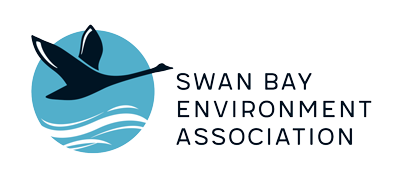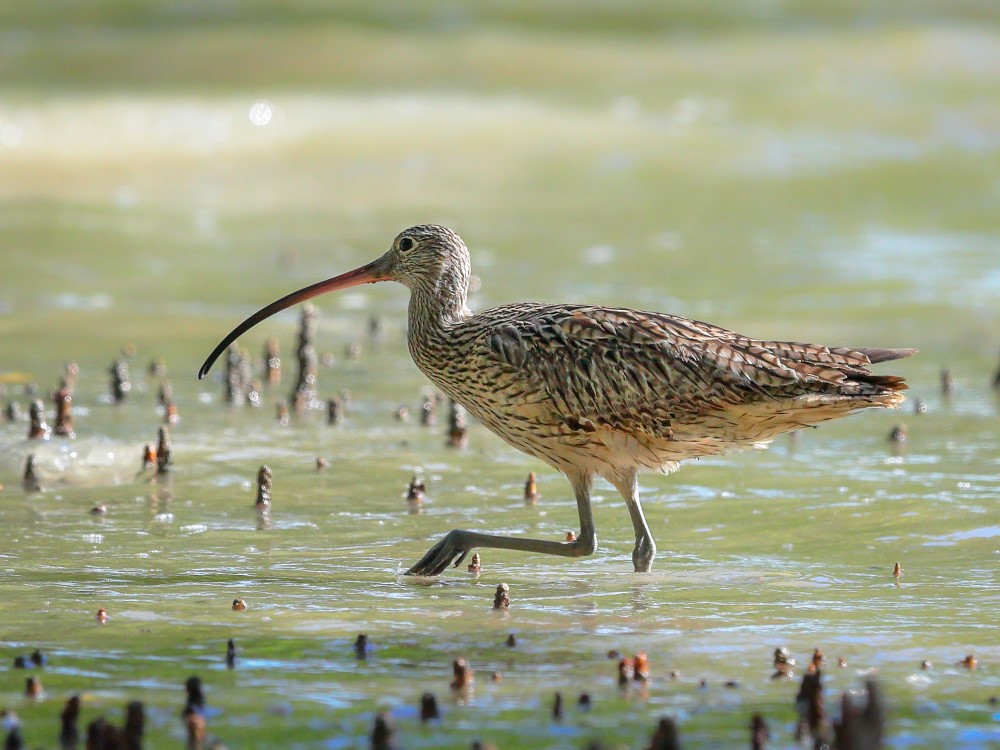
Migratory shorebirds
October is the time of year when thousands of migratory shorebirds fly in from Alaska, Siberia and the Arctic to rest and feed in Swan Bay. They make their return journey to the northern hemisphere in April. While in Swan Bay they gather to feed on the extensive tidal flats along the northern shoreline, in Stingaree Bight and between Swan and Duck islands. When the tide is high they roost in saltmarsh on the western shoreline, Edwards Point, Burnt Point, Swan Island and Sand Island.
Migratory shorebirds seen in greatest numbers are the Red-necked Stint, Curlew Sandpiper, Sharp-tailed Sandpiper, Bar-tailed Godwit, Eastern Curlew and Grey Plover. The Eastern Curlew is our largest international visitor and uses its long bill to probe mud for tubeworms.
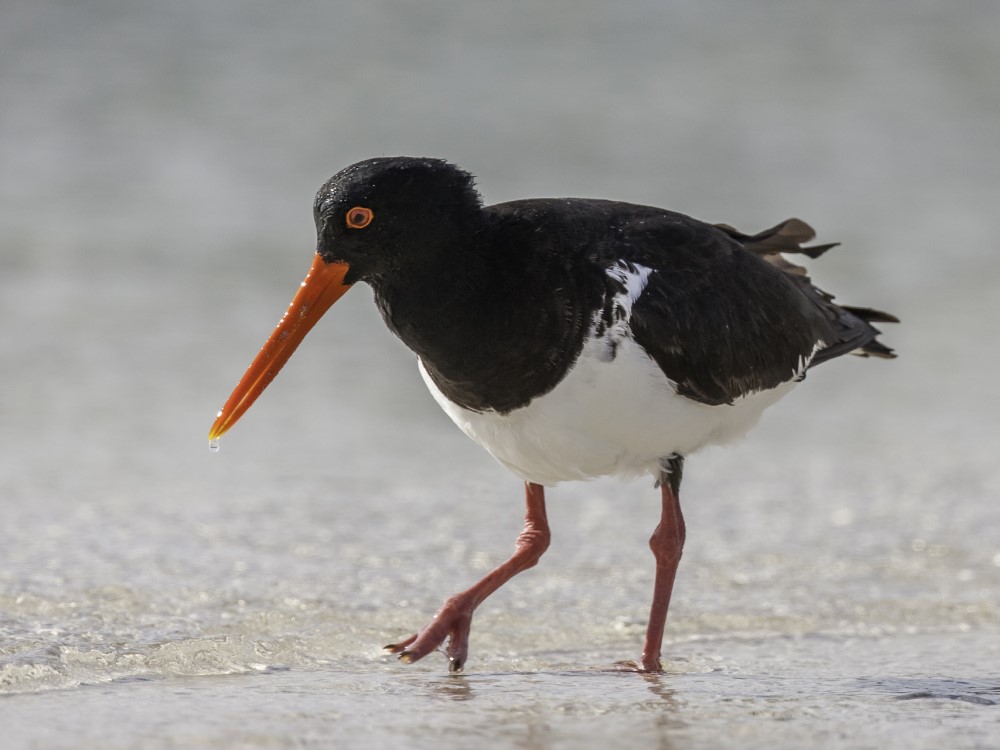
Resident shorebirds
Several shorebird species live year-round in Swan Bay. The Pied Oystercatcher is often seen on beaches, using its long orange bill to probe for food in the shallows and to break open snail shells. The Red-capped Plover scampers along beaches and then stops to peck at small invertebrates. Both species breed on Sand Island, laying their eggs on shallow scrapes in the sand.
Although often seen on local nature strips and in parks, the Masked Lapwing is also a resident shorebird. The Red-necked Avocet sweeps its long and upturned bill back and forth to find small insects and crustaceans in shallow water. The Black-winged Stilt picks off insects from the water’s surface.
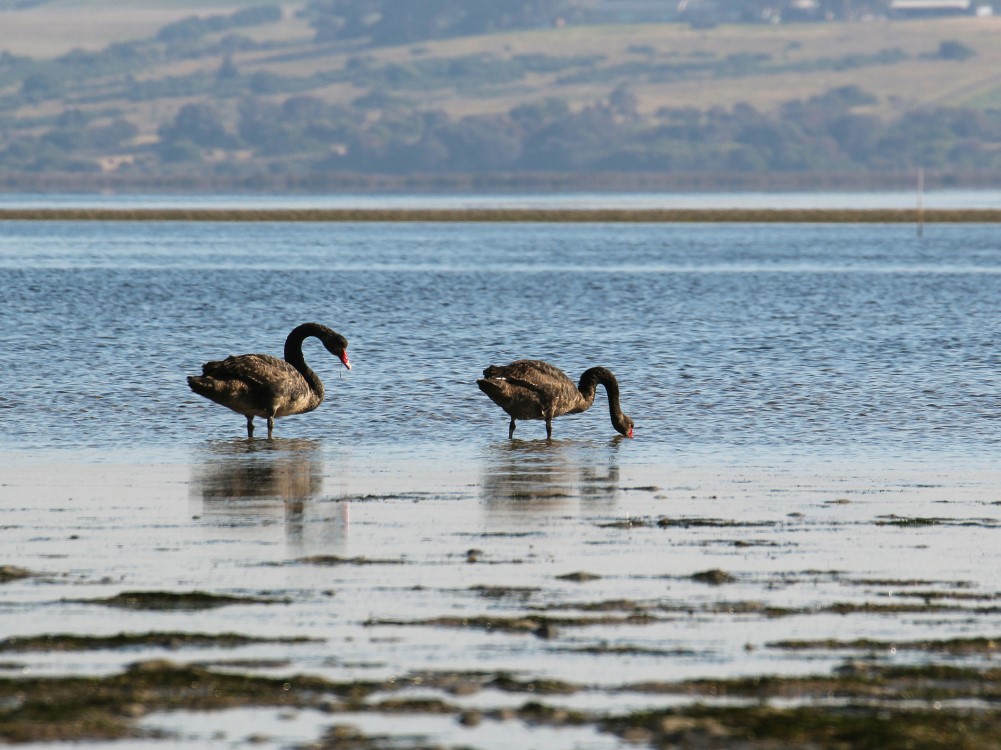
Waterbirds
The shallow depth of Swan Bay and its extensive seagrass meadows make it an ideal habitat for the Black Swan. The bird’s long neck allows it to reach seagrass, which is its main food source. Large grinding plates in the bird’s bill are used to crush the plant’s rhizomes.
Chestnut Teal and Pacific Black Duck are the most common ducks in Swan Bay. They both breed in the bay’s saltmarsh and use their bills to sieve food from the water surface. Other ducks recorded in Swan Bay are the Australian Shelduck, Australasian Shoveler, Hardhead, Pink-eared Duck and Musk Duck.
The shy Australian Spotted Crake and Buff-banded Rail feed on molluscs, crustaceans and insects, while the Great Crested Grebe dives for fish.
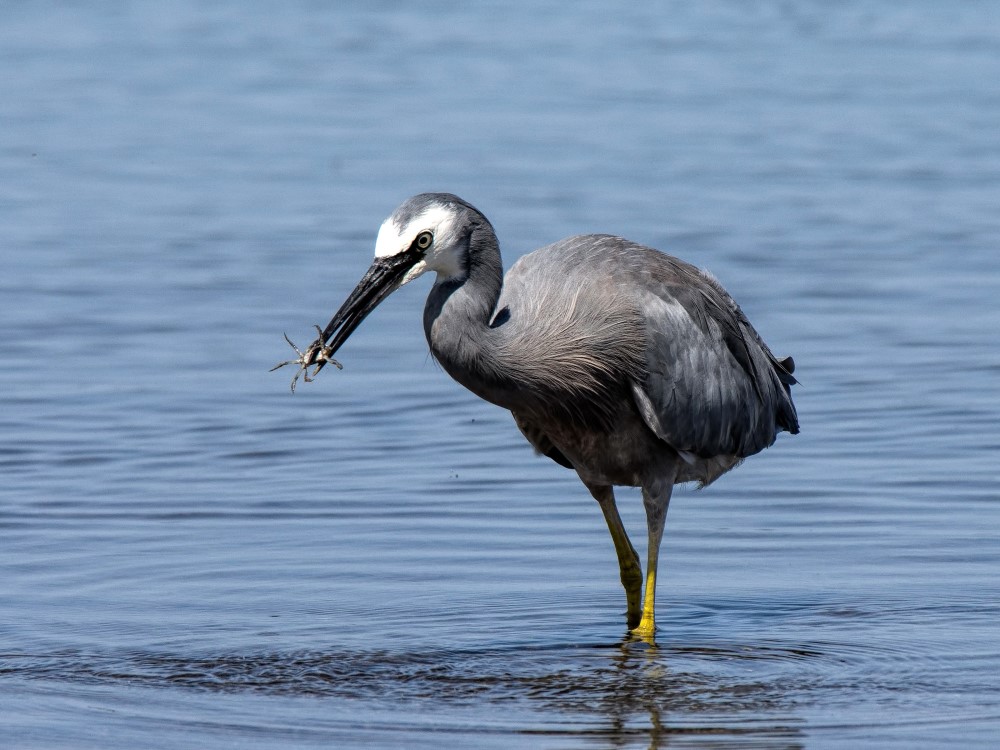
Large wading birds
During autumn and winter, large flocks of the Royal Spoonbill roost on Tip Island and near the Swan Bay Jetty. The bird uses its spoon-shaped bill like a vacuum cleaner hose, waving it back and forth in the muddy shallows to suck up shrimp and other small animals.
The White-faced Heron stalks its prey in the shallows where it lunges at fish and crabs, spearing or snatching them with its bill. Standing tall and still, the Great Egret waits for small fish to come within range. The Little Egret uses one of its feet to stir up fish and invertebrates. A long and curved bill is used by the Australian White Ibis to feed on small invertebrates in the mud. Large wading birds are also seen feeding in saltmarsh at low tide.
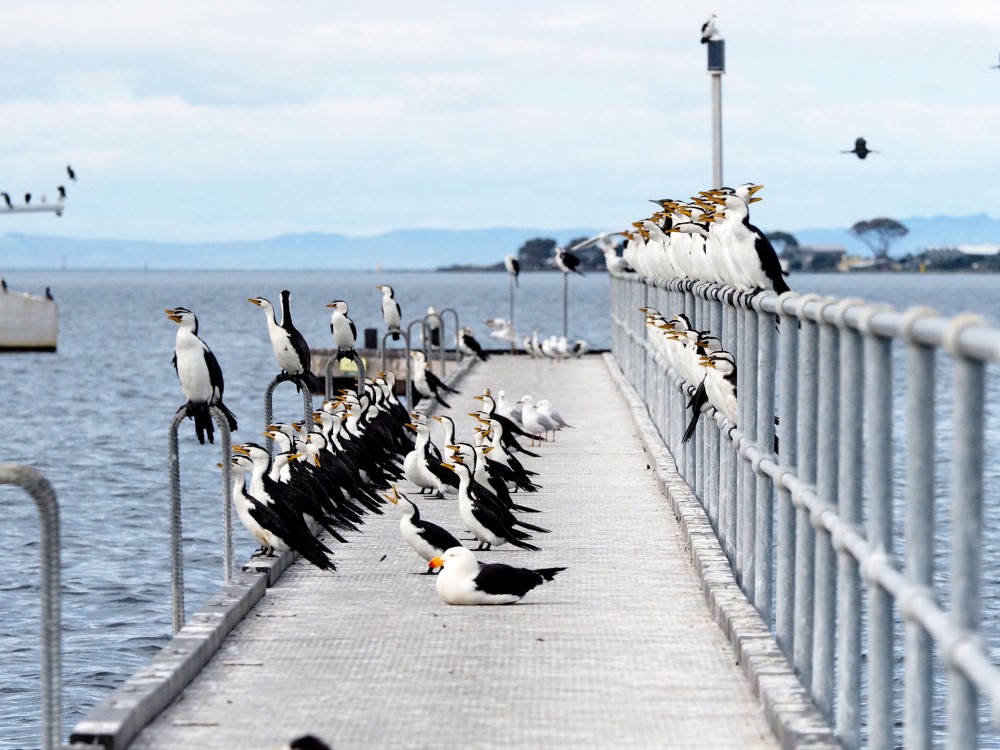
Seabirds
Seabird species seen in Swan Bay include the Little Tern, Fairy Tern, Caspian Tern, Australian Pelican, Australasian Gannet and Pied Cormorant. Sand Island is an important breeding site for the Fairy Tern, which dives for small fish in the bay. Pied Cormorants swim underwater to catch their feed of fish. As their feathers are not waterproof, the birds dry off by perching on jetties, dinghies and pipes with outstretched wings.
The White-bellied Sea-eagle flies low across the water and grabs fish in its talons. Stingaree Island supports a breeding colony of the Pied Cormorant. Small groups of the Crested Tern are often seen perched atop moored boats. Australasian Gannets breed on Pope’s Eye off Queenscliff and can be seen from beaches diving for fish.
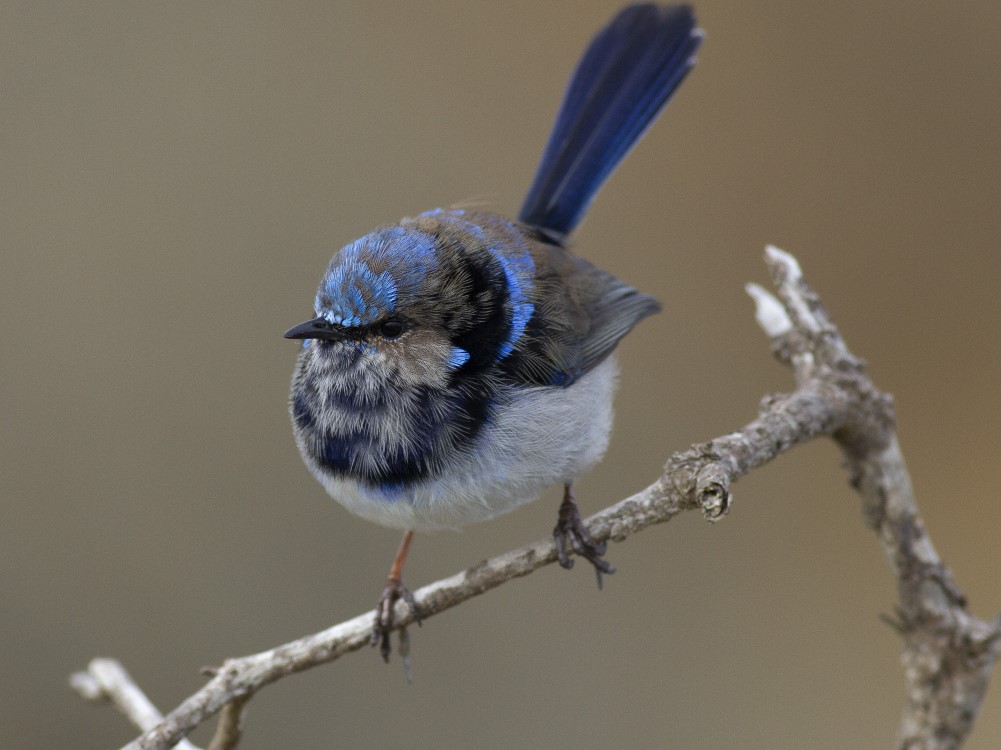
Birds on land
Patches of moonah woodland, grassland, coastal scrub and saltmarsh provide habitat for many land-based birds. Beetles, flies and bugs living in coastal saltmarsh are the favoured food for the White-fronted Chat. Small groups of the Superb Fairy Wren feed on insects on the ground or in low bushes.
The woodland at Edwards Point Wildlife Reserve is a good place to see the Brown Thornbill, a small bird that flies among shrubs and small trees feeding on insects, nectar and seeds. The Brown Falcon may swoop from its perch or drop from the sky to grab unsuspecting mammals, insects and reptiles. Eucalypt and grass seeds are eaten by the Crimson Rosella. A Black-shouldered Kite might be seen hovering above the saltmarsh on the lookout for small animals.
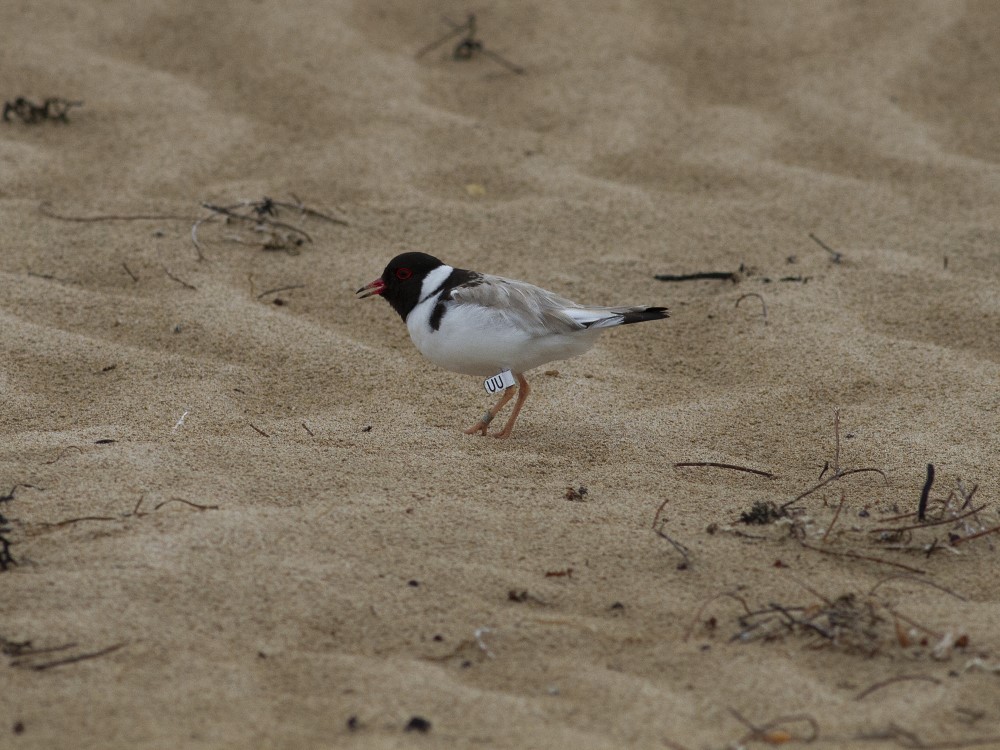
Threatened birds
Swan Bay is a refuge for threatened species suffering from the loss of their habitats elsewhere. It is one of only three Victorian sites where the critically endangered Orange-bellied Parrot spends winter and spring before returning to Tasmania. While in Swan Bay, it roosts in saltmarsh and feeds on the seeds of the Beaded Glasswort, Southern Sea-heath and Austral Sea-blite. Habitat loss and feral animal predation are two key factors in its decline.
The Lesser Sand Plover, Eastern Curlew, Great Knot and Red Knot are migratory shorebirds that are endangered due to habitat loss along their flight path. The Hooded Plover darts around the water’s edge in search of sandhoppers, crabs and molluscs. Other threatened birds include the Fairy Tern, Little Egret, Great Egret, Little Tern, Musk Duck and White-bellied Sea-eagle.
PHOTO CREDITS
Eastern Curlew: Georgina Steytler
Pied Oystercatcher: Georgina Steytler
Black Swans: Chris Tsernjavski
White-faced Heron: John Sharp
Pied Cormorants: John Sharp
Superb Fairy Wren: Jen Carr
Hooded Plover: Jen Carr
